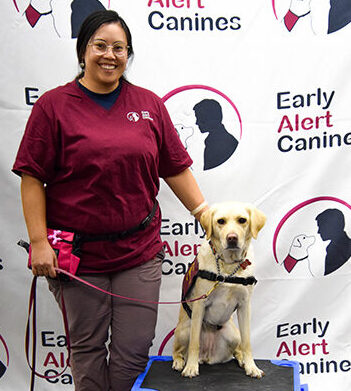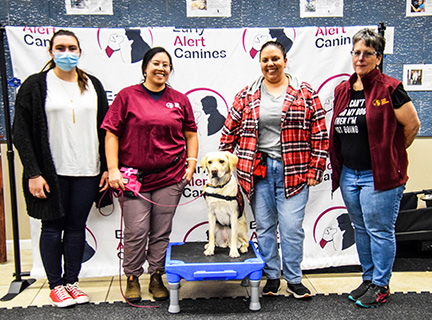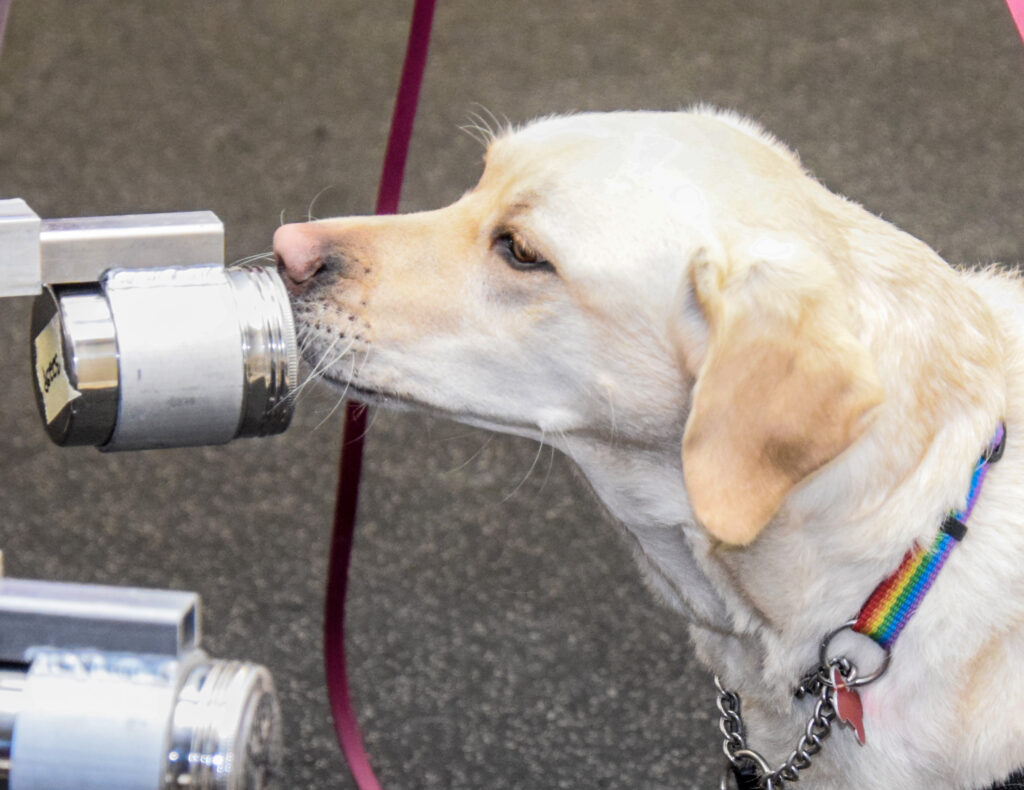By Jill Hedgecock Photos by Diane Walsh, endlesspaws28.comEAC

One-eighth of a dog’s brain is dedicated to detecting odor. The superior sniffing ability of dogs, who have 300 million smell receptors compared to a human’s six million, can help people in many ways. Dogs can sniff out cancer. Search and rescue canines can locate the scent trail of missing people. They can assist law enforcement and the military using their sense of smell to locate drugs and explosives.
For insulin-dependent diabetics, the noses of these amazing companions can save lives. A dog’s ability to detect low blood sugar inspired Carol Edwards to start Early Alert Canines (EAC) over a decade ago. EAC trains and places Medical Alert Service Dogs with diabetics. The diabetic service dogs must be taught to alert their humans of a blood sugar problem when they are walking, sleeping, at a desk, and while driving. These canines can beat electronic alert systems for low blood sugar sometimes by 15 to 20 minutes. EAC’s diabetic program is unique in that they specialize in working with children and their parents. Their youngest diabetic client was a three-year old, and her dog had to learn to alert the parent not the child.
Victoria Briskin, EAC’s Development Director, describes the work that EAC does for diabetics as life-changing and lifesaving, because the dogs are able to quickly detect a problem. “The client does not have to wait to experience the symptoms of a low or the symptoms of a high.”

Carol Edwards, the Executive Director, described how rewarding starting EAC has been for her and how much the team is learning about the long-term benefits with early alerts. Their 3-year-old client is now 13. “I would love to see how being able to stay within a normal blood sugar range [has helped]. What’s her life going to be like as she becomes an adult? Is she going to have good vision? Will none of her organs fail her because the dog is still faster than the medical device and the dog has caught something before the person is in a bad way.”
Now, EAC has undertaken a new detection challenge. They have partnered with the California Department of Public Health (CDPH) to train two dogs in a pilot program to detect COVID-19 in school children. The goal of the program is to evaluate whether dogs can detect Covid infections similar to, or with increased accuracy, as compared to rapid over-the-counter nasal swab tests. The study involves schoolchildren taking a home test as well as being presented to Scarlett or Rizzo to be scent checked.
Two yellow labs, Scarlett and Rizzo, who were career-change dogs from Canine Companions, were initially evaluated by head trainer, Elizabeth Johnston of EAC, as to their suitability for the COVID-19 study for four months. Johnston, who has been training dogs for over 30 years, taught Scarlett and Rizzo to sniff individual cannisters on a scent wheel and to sit when they detected the volatile odors emitted based on COVID-19 patient’s discarded socks. Their preliminary training was performed using a double-blind test where Johnston and the dog both did not know where the positive COVID-19 cannister was located. The two dogs passed with flying colors.


“Over 400 blinds were required to prove that the dogs knew what they were doing,” said Johnston who was impressed with Scarlett and Rizzo. “These guys are brilliant. They’re so fast. They’re so smart. They’re so easy to train.”
In February 2022, the dogs were confirmed as suitable for the program and individual handlers were hired. Collette Yee became Rizzo’s handler and Alysia Santos became Scarlett’s handler. Within a week of being brought onto the team, Yee and Santos were taking the dogs to schools to launch the study. Yee, who has a background in training wildlife conservation dogs, admitted it is impossible not to get attached to the dogs she trains.
Collette Yee described how impressed she was one day when Rizzo was off duty at a drive-up COVID-19 test site. A car drove up about 100 feet away and when the passenger left the car to line up for the dog test, Rizzo alerted. “That was really fun to see. Before I even asking her to search, she picked it [the COVID-19 scent] up.”
Alysia Santos, who grew up volunteering at local animal shelters, became a service dog puppy raiser in Florida and later in California. Santos described how rewarding it was when Scarlett identified a COVID-19-positive child in a line up when the child’s nasal swab test gave a questionable result. “Scarlett just lit up. She was wagging her tail. It was really awesome seeing all the work we’d done here transferred to out in the field.”
On occasion, EAC’s COVID-19 dogs have given false positives when the dogs were presented to people who were symptomatic with a respiratory illness. EAC suspects that the patients may have had the flu and were giving off a similar VOC scent as COVID-19.
When the COVID-19 dogs are not working or being trained, they live in a foster home. Chip Bishop, who works nearby, and his wife, have fostered about 70 dogs over the last 11 years for EAC. Sometimes they have kept the dog only one or two nights, but typically they foster for about one month. Because the COVID-19 dog study is long-term, they have been caring for Scarlett for longer than normal.
“It’s really a win/win for us,” said Bishop about fostering. “The dogs are very well-trained and behaved. We don’t have puppy issues when they’re young. We don’t have end of life issues and vet bills. When we travel, they’re [EAC] great about finding coverage. Each one of them has a piece of my heart.”
In a Center for Disease Control Foundation podcast interview called “Contagious Conversations,” Dr. Carol Glaser of the California Department of Public Health (CDPH) discussed the many benefits of using dogs for COVID testing.
Dog testing avoids the discomfort of nasal swabbing, results in the reduction of plastic waste associated with medical testing and requires the kids to spend less time outside the classroom. But most of all, the dogs evoked a positive response to testing from the students.
“They absolutely love the dogs,” said Glaser.
With the waning severity of COVID-19 infections, it is unclear what future role Scarlett, Rizzo and other COVID dogs will play in assisting schools or other facilities in protecting public health.
“We have been in discussions with CDPH with what’s next,” said Edwards. “We have been successful in showing proof of concept. And now we are talking about what other diseases we can help with.”
According to Edwards, tuberculosis and RSV have been discussed. But if it turns out there is no next study, Scarlett and Rizzo will become part of the diabetic program.
“Once a dog is scent trained, it is very easy to put a second scent on them,” said Edwards.
This is good news for public health officials. As EAC and other organizations discover more applications for a dog’s scent detection capabilities, the potential for dogs to help curb the spread of human diseases, especially during a pandemic, may become invaluable.
Funding for Early Alert Canines, an incorporated 501(c)(3) non-profit organization (Tax ID is #27-4237968), operates almost entirely by private individual donations and grants. Temporary foster homes are also needed. To help, visit www.earlyalertcanines.org.


Jill Hedgecock has degrees in Biological Science and Environmental Science. She writes Diablo Gazette’s pet rescue column, and is the author of two dog inspired novels, “Between Shadow’s Eyes” and “From Shadow’s Perspective.”

